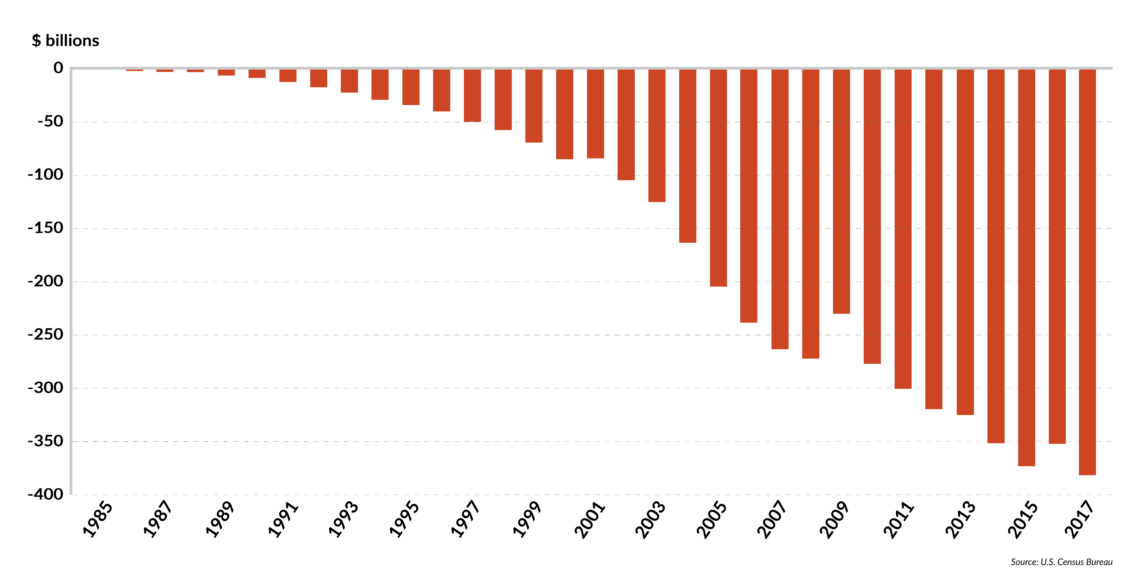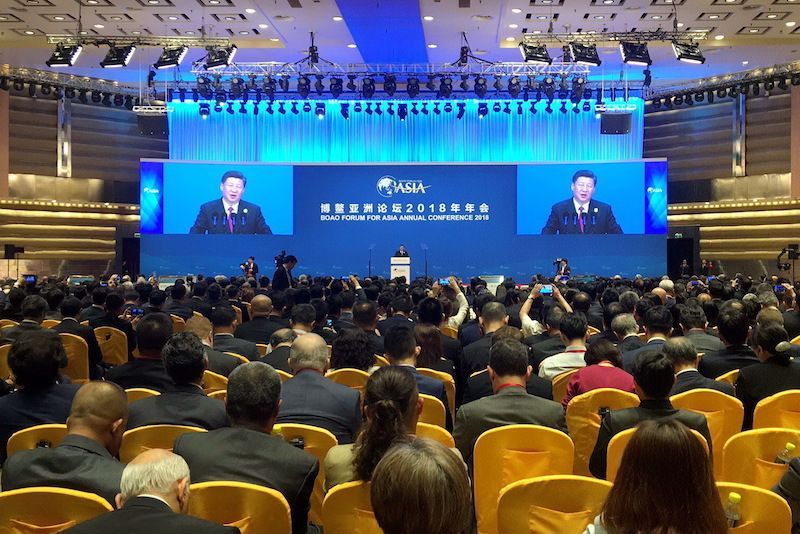China refreshens old promises to open up its domestic market
Chinese President Xi Jinping’s April pledge to allow more foreign competition in the country’s manufacturing and financial services sectors, and to respect Western companies’ intellectual property rights, momentarily eased the tension between Washington and Beijing.

In a nutshell
- The leader of China listed 10 key areas where his country’s economy is to open up to foreign competition up in 2018
- The pledge is short on details and not the first of its kind, but this time Chinese officials have adopted a timeframe for changes
- The U.S. demand for a rapid balancing of its trade with China is not likely to be met with the measures announced thus far
The Boao Forum for Asia, sometimes called Asia’s Davos, is China’s platform for presenting itself globally and for the country’s top leaders to make important new proclamations. Before this year’s edition, stock markets anxiously awaited Chinese President Xi Jinping’s keynote speech at the forum.
The president’s anticipated trade proposals, delivered at a tense time in United States-China relations, when even a trade war was beginning to look possible, have had a calming effect. U.S. President Donald Trump praised the speech in his tweets. Relieved, the financial markets rallied. In New York, the Dow Jones surged, opening 2.2 points, while London’s mining heavyweights climbed higher with metal prices. The FTSE 100 hit a six-week high. Bourses in China and Hong Kong reacted in a similar fashion. However, investors’ and the U.S. president’s optimism about resolving the issues between the trading giants may be premature.
At the heart of the problem is what the Chinese leader actually put on the table during the Boao forum, and what sort of an impact these proposals are likely to have on China’s domestic companies and their international competitors.
Few details
In his speech, President Xi listed 10 key areas where China’s economy is to open up in 2018. They included the country’s financial services market and its automotive industry. China’s imports are to rise due to “significantly” lowered tariffs on goods, such as automobiles; and the protection of intellectual property is to be strengthened. There is also a promise to relax the regulatory regimen in China’s free trade zones for foreign investors.
So, let us take a closer look at the three key parts of the president’s offering: the import tariffs, manufacturing, and the service sector.
China is still working out the details on its plan to ‘significantly’ reduce the import tariffs.
On lowering tariffs for foreign goods, no detailed information has been provided. President Xi mentioned only vehicles, possibly in response to the concerns expressed by U.S. President Donald Trump in his tweets. The latter observed that the U.S. charged only a 2.5 percent tariff on imported Chinese vehicles, while in China the rate on U.S.-made cars has been 25 percent. At this point, though, one can only assume that China is still working out the details on its plan to “significantly” reduce the import tariffs.
The situation is similar in manufacturing. Aside from the automobile industry, President Xi named no specific sectors. At present, foreign carmakers in China are limited to 50 percent stakes in joint ventures; they cannot establish their own, wholly-owned factories. The Chinese leader now promises to ease the restrictions on these joint ventures, which may indicate that China will allow foreigners to have majority stakes. Otherwise, the ownership restriction would have been removed completely. Some as-yet unspecified changes in shipbuilding and airplane industries are also expected. However, the Chinese authorities have not offered any timeline for that.
Hidden gains
In any case, both the Chinese and joint-venture carmakers in China will be facing increased competition. The Chinese leadership is quite confident that the country’s automobile industry is ready for that. It has developed enough and gained a sufficient share of the market (mainly in the low-price end) that it can stand its ground against foreign car companies. The Chinese government also hopes to increase productivity in the domestic car sector by pushing it into a more demanding environment. In the long term, reduced import tariffs on vehicles, particularly the luxury models, will force China’s domestic auto industry to upgrade its technologies.
With lowered tariffs, high-value car producers are set to become top beneficiaries in the Chinese market. Reportedly, Tesla, Inc. CEO Elon Musk is looking forward to the company’s fully-owned production site in Shanghai, and U.S. luxury car makers such as Lincoln (a division of the Ford Motor Company) cannot wait to enter the immense Chinese market. Several smaller carmakers from Europe might establish their footholds in China as well.
Another sector that President Xi mentioned in his proposals was financial services. Again, he was not forthcoming with much detail, but Yi Gang, the newly appointed governor of the People’s Bank of China, elaborated on the extent to which the country plans to open this sector to foreign investors.
Easing restrictions
First, the existing limits on foreign ownership in the financial sector will be eased. For all foreign investors, Mr. Yi said, a 51 percent stake in securities, fund management, futures and life insurance companies will be allowed by June 2018, with the restriction to be removed entirely in three years. The current ownership cap for securities, futures and fund management firms is 49 percent, and the cap for insurance companies is 50 percent – limits that exclude majority control.

Additionally, foreigners’ access to China’s financial market will be eased by ending the practice of requiring foreign insurers to have a representative office in China for two years before they can set up a business there. And by the end of 2018, ownership caps for investment in wealth management companies set up by commercial banks are to expire. China will also allow foreign investors to enter its trust, financial leasing, auto finance and consumer finance sectors by the same deadline. The government claims that under these new rules, foreign financial companies can compete on an equal footing with domestic firms in China.
The combined market share of foreign banks in China remains below 2 percent.
Second, China promises to quadruple the daily quota on the Hong Kong-Shanghai and Hong Kong-Shenzhen stock link schemes from the start of May, a move aimed at increasing integration of the country’s onshore and offshore stock market trading. China is also trying to launch a trading link to allow its investors trade in shares listed on the London Stock Exchange.
Beijing has pledged to open up its financial services sector before. Many foreign commercial banks set up branches in China after the country’s accession to the World Trade Organization in 2001, in anticipation of such moves. Seventeen years later, though, the combined market share of foreign banks in China remains below 2 percent, due to the government’s reluctance to remove restrictions.
The difference this time around is that the Chinese leadership has committed to a time schedule for the reform. This gives foreign companies new hope that the promises finally will materialize.
U.S. expectations
Given President Trump’s repeated threats to retaliate over the persistent U.S. trade deficit with China, many observers hailed President Xi’s Boao Forum proposals as a sign of Beijing’s readiness to make concessions necessary to avert a full-blown trade war. Many perceive that Mr. Trump’s tariff threats actually made an impression on the Chinese leader. Let us examine, then, what the U.S. president originally demanded and what his Chinese counterpart has been ready to concede at this point.
During the March 2018 Washington talks with Vice Premier Liu He, China’s new economic tsar, the Trump administration insisted that China ought to reduce its trade surplus with the U.S. by $100 billion per year so that in three to four years the two countries’ exchange will be balanced. In 2017, the U.S. deficit with China was $375 billion. Second, China should start respecting Western companies’ intellectual property and discard its “market for technology” forced know-how transfer policy. Third, China should grant U.S. companies more access to its own market. And fourth, China should alter its “Made in China 2025” strategy, which positions its state-owned enterprises (SOEs) as technological innovation and manufacturing centers backed with government subsidies and preferential treatment. In Washington’s opinion, China ought to have a market-driven economy, not a government-led one.
President Xi’s Boao message indicates that China is prepared to do something to address the U.S. trade deficit concern. Chinese consumers may buy some American luxury cars and the Chinese government can purchase a considerable amount of U.S. shale gas. Yet, such transactions can hardly amount to the $100 billion reduction in the trade imbalance demanded by the U.S. side. From the Chinese perspective, a $20 billion per year cut might be a realistic target.
Scenarios
On the issue of the protection of intellectual property rights (IPR), China will do something at the provincial level. President Xi promised that his government will “significantly raise the cost for offenders and unlock the deterrent effect of laws.” However, the stealing of foreign technology often takes place on the state level, as the Chinese government quietly encourages SOEs, private companies and military contractors to violate IPR rules. As a result, President Trump should not expect quick and significant progress in this area.
With regard to foreign access to its service and manufacturing sectors, China’s concessions are rather likely. Chinese leaders know that liberalization in these areas is unlikely to lead to significant change as SOEs, mainly central government’s SOEs, have a dominant position. It is not realistic to demand that China change its government-led economic model by reducing the role of the SOEs in key sectors. For the Chinese leadership, a mixed-economy system can be tolerated, but only under the condition that state enterprises dominate in the upstream sectors. The SOEs are the economic pillar of China’s political system.
To summarize, President Xi’s Boao liberalization pledge can be seen as another link in the long chain of promises China has been dangling in front of foreigners. Many Western companies are tired of waiting and display some signs of “promises fatigue.” That said, it still matters if, and to what extent, China will keep its word. Even if the Boao liberalization package becomes implemented only in part, foreign companies that operate in the sectors affected stand to benefit.
As for the trade war threat, the president of China has succeeded in easing the tensions – for the time being. President Trump expects more concessions. His administration can still do things unilaterally, and imposing tariffs on up to $150 billion worth of imports from China is one of its options. This would be a serious blow to the Chinese economy.
Yet experience shows that trade wars always end up harming all the sides involved. It is up to the two governments to come up with economically smart, but also face-saving solutions. If Mr. Xi could deliver on the promises he has made at Boao, significant gains for the U.S. and other foreign businesses in China would follow. The demands that the Trump administration had made of China last March, however, especially the point regarding the “Made in China 2025” strategy, are not realistic in the eyes of the Chinese.






